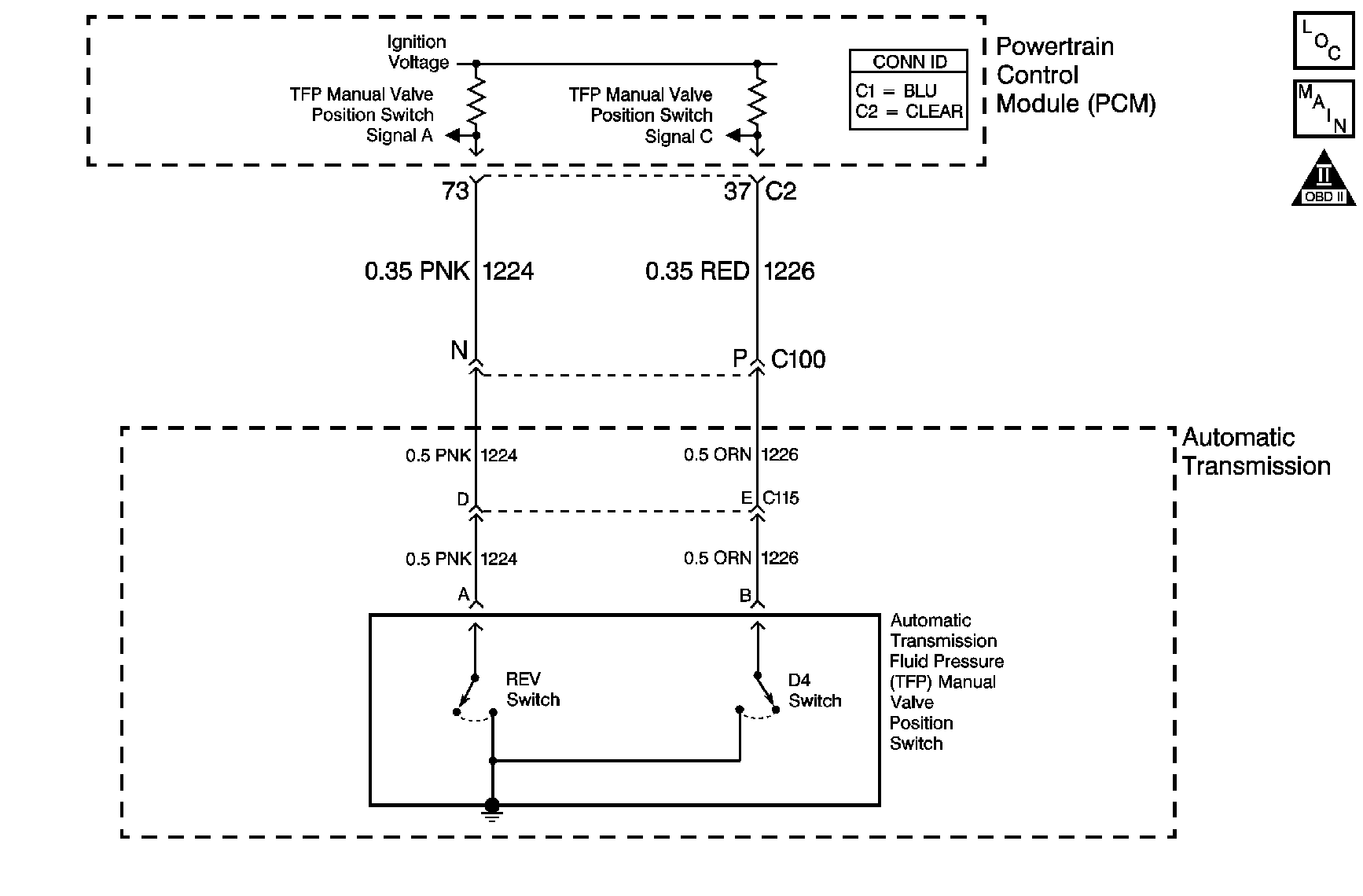
Circuit Description
The automatic transmission fluid pressure (TFP) manual valve position switch consists of two normally-open pressure switches. The assembly is attached to the lower control valve body.
The PCM supplies ignition voltage on the two range signal circuits, signal circuit A and signal circuit C. By grounding one of the switches with fluid pressure from the manual valve, the PCM detects a garage shift from PARK/NEUTRAL to REVERSE or DRIVE, D1, D2, D3, or D4. Refer to the Transmission Fluid Pressure Manual Valve Position Switch Logic table. This information is used by the PCM in order to adjust line pressure during garage shifts.
If one of the following conditions occur, garage shifts may become harsh:
| • | An open signal circuit |
| • | A signal circuit shorted to ground |
| • | A damaged or leaking pressure switch seal |
| • | Sediment or debris in a pressure switch |
| • | Damaged or stuck pressure switch contacts |
Test Description
The numbers below refer to the step numbers on the diagnostic table.
-
This step tests the indicated range signal to the manual valve range actually selected.
-
This step tests for correct voltage from the PCM.
Step | Action | Value(s) | Yes | No |
|---|---|---|---|---|
1 | Did you perform the Transmission Fluid Checking Procedure? | -- | Go to Step 2 | Go to Transmission Fluid Check |
Does each selected transmission range match the scan tool TFP Sw. display? | -- | Go to Intermittent Conditions in Engine Controls | Go to Step 3 | |
3 |
Does the scan tool TFP Sw. Sig. A/Sig. C parameter indicate HI for both range states? | -- | Go to Step 4 | Go to Step 6 |
Refer to Automatic Transmission Inline Harness Connector End View . Does the voltage measure ignition voltage at both terminals? | -- | Go to Step 5 | Go to Step 7 | |
5 | Connect a fused jumper wire from terminal N of the J 44152 , signal A circuit, to ground while monitoring the scan tool TFP Sw. Sig. A/Sig. C parameter. Refer to Automatic Transmission Inline Harness Connector End View . When the signal A circuit (CKT 1224) is grounded, does the signal C circuit (CKT 1226) indicate LOW? | -- | Go to Step 8 | Go to Step 9 |
6 | Test the signal circuit or circuits (CKTs 1224, and/or 1226) of the TFP manual valve position switch which did not indicate HI for a short to ground between PCM connector C2 and the AT inline 20-way connector. Refer to Circuit Testing and Wiring Repairs in Wiring Systems. Did you find and correct a condition? | -- | Go to Step 13 | Go to Step 12 |
7 | Test the signal circuit or circuits (CKTs 1224, and/or 1226) of the TFP manual valve position switch which did not indicate ignition voltage for an open between PCM connector C2 and the AT inline 20-way connector. Refer to Circuit Testing and Wiring Repairs in Wiring Systems. Did you find and correct a condition? | -- | Go to Step 13 | Go to Step 12 |
8 | Test the signal circuits (CKTs 1224 and 1226) of the TFP manual valve position switch for a shorted together condition between PCM connector C2 and the AT inline 20-way connector. Refer to Circuit Testing and Wiring Repairs in Wiring Systems. Did you find and correct the condition? | -- | Go to Step 13 | Go to Step 12 |
9 | Test the signal circuits (CKTs 1224 and 1226) of the TFP manual valve position switch for an open or shorted condition between the AT inline 20-way connector and the TFP manual valve position switch. Refer to Circuit Testing in Wiring Systems. Did you find a condition? | -- | Go to Step 10 | Go to Step 11 |
10 |
Important: The automatic transmission wiring harness consists of two separate harnesses, the Automatic Transmission Wiring Harness Assembly, GM P/N 15320475, and the Automatic Transmission Wiring Extension Harness Assembly, GM P/N 15320478. In order to avoid the unnecessary replacement of parts, determine which harness contains the fault and replace only that harness. Replace the automatic transmission wiring harness. Refer to Transmission Overhaul in the 4T80-E section of the Transmission Unit Repair Manual. Did you complete the replacement? | -- | Go to Step 13 | -- |
11 | Replace the TFP manual valve position switch. Refer to Transmission Overhaul in the 4T80-E section of the Transmission Unit Repair Manual. Did you complete the replacement? | -- | Go to Step 13 | -- |
12 | Replace the PCM. Refer to Powertrain Control Module Replacement in Engine Controls. Is the replacement complete? | -- | Go to Step 13 | -- |
13 | Perform the following procedure in order to verify the repair:
Does each selected transmission range match the scan tool TFP Sw. display? | -- | System OK | Go to Step 1 |
